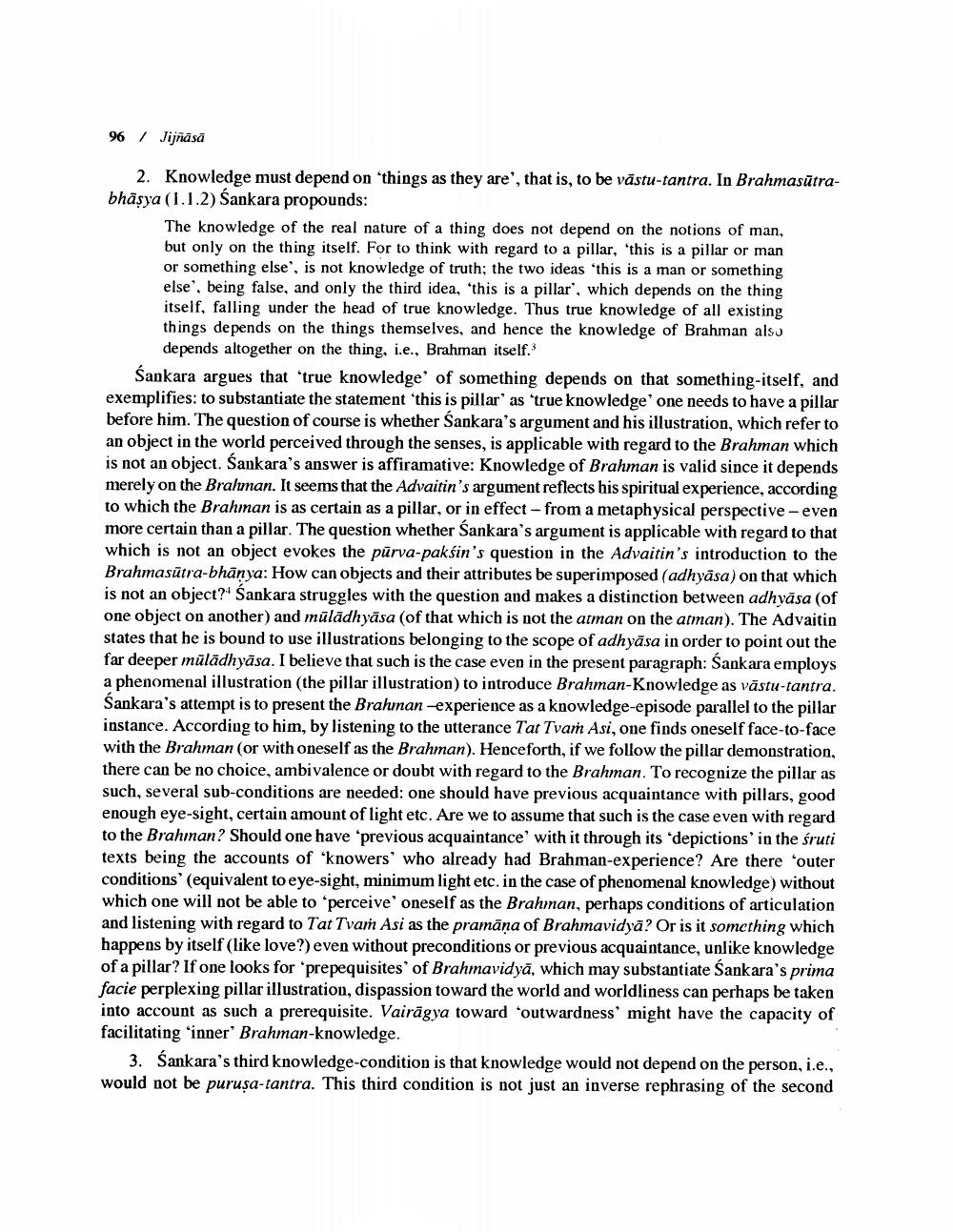________________
96
/ Jijñāsā
2. Knowledge must depend on things as they are', that is, to be vāstu-tantra. In Brahmasūtrabhâsya (1.1.2) Sankara propounds:
The knowledge of the real nature of a thing does not depend on the notions of man, but only on the thing itself. For to think with regard to a pillar, 'this is a pillar or man or something else, is not knowledge of truth; the two ideas 'this is a man or something else', being false, and only the third idea, 'this is a pillar', which depends on the thing itself, falling under the head of true knowledge. Thus true knowledge of all existing things depends on the things themselves, and hence the knowledge of Brahman also
depends altogether on the thing, i.e., Brahman itself. Sankara argues that 'true knowledge of something depends on that something-itself, and exemplifies: to substantiate the statement this is pillar' as true knowledge' one needs to have a pillar before him. The question of course is whether Sankara's argument and his illustration, which refer to an object in the world perceived through the senses, is applicable with regard to the Brahman which is not an object. Sankara's answer is affiramative: Knowledge of Brahman is valid since it depends merely on the Brahman. It seems that the Advaitin's argument reflects his spiritual experience, according to which the Brahman is as certain as a pillar, or in effect - from a metaphysical perspective - even more certain than a pillar. The question whether Sankara's argument is applicable with regard to that which is not an object evokes the pūrva-paksin's question in the Advaitin's introduction to the Brahmasūtra-bhānya: How can objects and their attributes be superimposed (adhyāsa) on that which is not an object?' Sankara struggles with the question and makes a distinction between adhväsa (of one object on another) and mūlādhyāsa (of that which is not the atman on the atman). The Advaitin states that he is bound to use illustrations belonging to the scope of adhyāsa in order to point out the far deeper mülādhyāsa. I believe that such is the case even in the present paragraph: Sankara employs a phenomenal illustration (the pillar illustration) to introduce Brahman-Knowledge as vāstu-tantra. Sankara's attempt is to present the Brahman-experience as a knowledge-episode parallel to the pillar instance. According to him, by listening to the utterance Tat Tvarn Asi, one finds oneself face-to-face with the Brahman (or with oneself as the Brahman). Henceforth, if we follow the pillar demonstration, there can be no choice, ambivalence or doubt with regard to the Brahman. To recognize the pillar as such, several sub-conditions are needed: one should have previous acquaintance with pillars, good enough eye-sight, certain amount of light etc. Are we to assume that such is the case even with regard to the Brahman? Should one have previous acquaintance' with it through its depictions in the śruti texts being the accounts of 'knowers' who already had Brahman-experience? Are there "outer conditions (equivalent to eye-sight, minimum light etc. in the case of phenomenal knowledge) without which one will not be able to 'perceive' oneself as the Brahman, perhaps conditions of articulation and listening with regard to Tat Tvam Asi as the pramāņa of Brahmavidyā? Or is it something which happens by itself (like love?) even without preconditions or previous acquaintance, unlike knowledge of a pillar? If one looks for prepequisites' of Brahmavidyā, which may substantiate Sankara's prima facie perplexing pillar illustration, dispassion toward the world and worldliness can perhaps be taken into account as such a prerequisite. Vairāgya toward 'outwardness' might have the capacity of facilitating 'inner' Brahman-knowledge.
3. Sankara's third knowledge-condition is that knowledge would not depend on the person, i.e., would not be purusa-tantra. This third condition is not just an inverse rephrasing of the second




